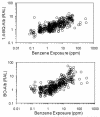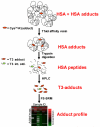Adductomics: characterizing exposures to reactive electrophiles
- PMID: 21501670
- PMCID: PMC4758449
- DOI: 10.1016/j.toxlet.2011.04.002
Adductomics: characterizing exposures to reactive electrophiles
Abstract
To understand environmental causes of disease, unbiased methods are needed to characterize the human exposome, which represents all toxicants to which people are exposed from both exogenous and endogenous sources. Because they directly modify DNA and important proteins, reactive electrophiles are probably the most important constituents of the exposome. Exposures to reactive electrophiles can be characterized by measuring adducts from reactions between circulating electrophiles and blood nucleophiles. We define an 'adductome' as the totality of such adducts with a given nucleophilic target. Because of their greater abundance and residence times in human blood, adducts of hemoglobin (Hb) and human serum albumin (HSA) are preferable to those of DNA and glutathione for characterizing adductomes. In fact, the nucleophilic hotspot represented by the only free sulfhydryl group in HSA (HSA-Cys(34)) offers particular advantages for adductomic experiments. Although targeted adducts of HSA-Cys(34) have been monitored for decades, an unbiased method has only recently been reported for visualizing the HSA-Cys(34) 'subadductome'. The method relies upon a novel mass spectrometry application, termed fixed-step selected reaction monitoring (FS-SRM), to profile Cys(34) adducts in tryptic digests of HSA. Here, we selectively review the literature regarding the potential of adductomics to partially elucidate the human exposome, with particular attention to the HSA-Cys(34) subadductome.
Copyright © 2011 Elsevier Ireland Ltd. All rights reserved.
Figures




References
-
- Aldini G, Gamberoni L, Orioli M, Beretta G, Regazzoni L, Maffei Facino R, Carini M. Mass spectrometric characterization of covalent modification of human serum albumin by 4-hydroxy-trans-2-nonenal. J. Mass Spectrom. 2006;41:1149–1161. - PubMed
-
- Aldini G, Vistoli G, Regazzoni L, Gamberoni L, Facino RM, Yamaguchi S, Uchida K, Carini M. Albumin is the main nucleophilic target of human plasma: a protective role against pro-atherogenic electrophilic reactive carbonyl species? Chem. Res. Toxicol. 2008;21:824–835. - PubMed
-
- Ames BN. Dietary carcinogens and anticarcinogens, oxygen radicals and degenerative diseases. Science. 1983;221:1256–1264. - PubMed
-
- Armstrong B, Doll R. Environmental factors and cancer incidence and mortality in different countries, with special reference to dietary practices. Int. J. Cancer. 1975;15:617–631. - PubMed
-
- Beck JL, Ambahera S, Yong SR, Sheil MM, de Jersey J, Ralph SF. Direct observation of covalent adducts with Cys34 of human serum albumin using mass spectrometry. Anal. Biochem. 2004;325:326–336. - PubMed
Publication types
MeSH terms
Substances
Grants and funding
LinkOut - more resources
Full Text Sources
Other Literature Sources

